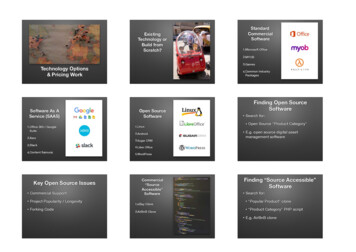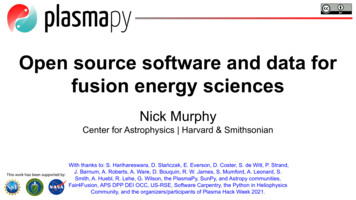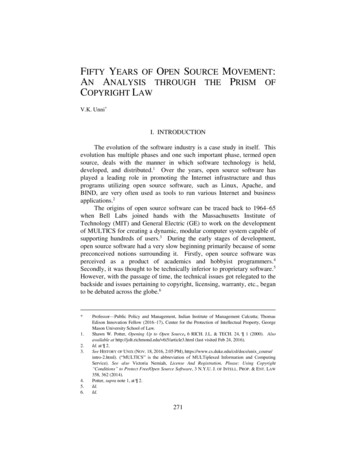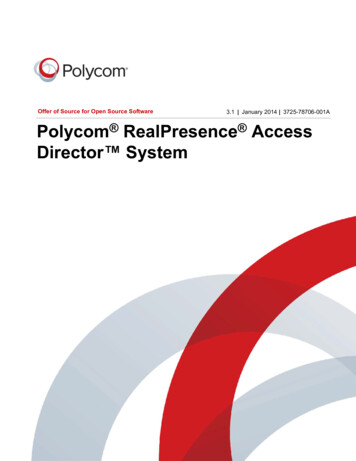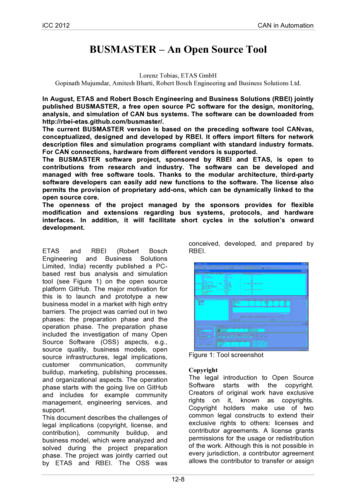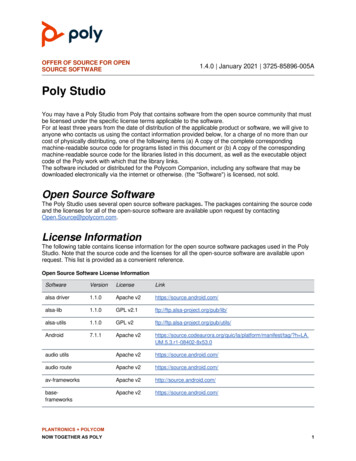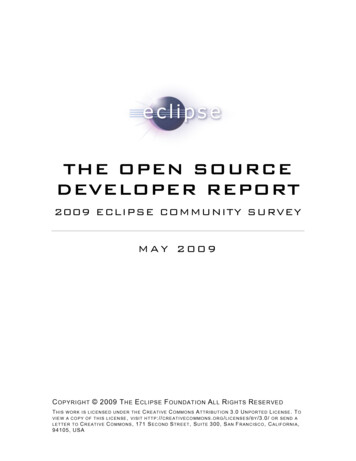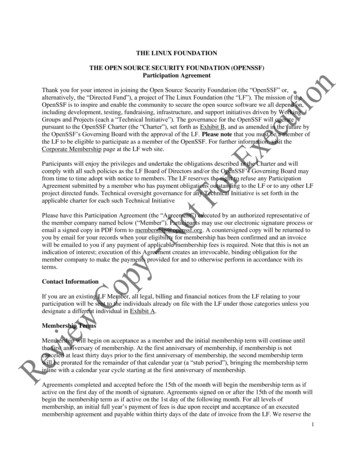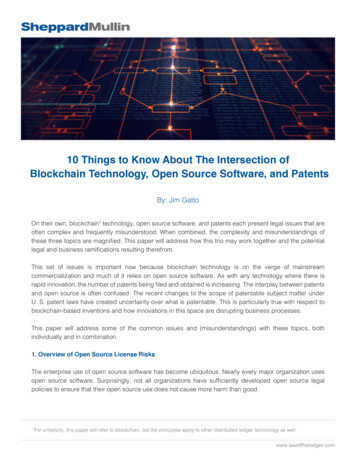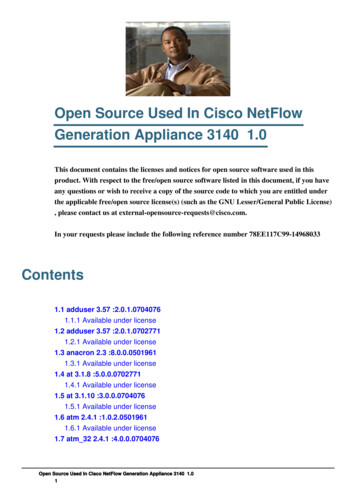
Transcription
EFFECTIVENESS OF OPEN SOURCE DATA LOSSPREVENTION TOOL IN CLOUD COMPUTINGMAHATHIR BIN SULAIMANA project report submitted in partial fulfillment ofthe requirement for the award of the degree ofMaster of Computer Science (Information Security)Advanced Informatics SchoolUniversiti Teknologi MalaysiaJUNE 2013
iiiACKNOWLEDGEMENTFirst of all, I would like to express my deepest gratitude to Allah Almighty aswith His blessing this project has been successful. I would also like to express myappreciation to my supervisor, Dr Bharanidharan Shanmugam, with his help, guidanceand encouragement in preparing this thesis. Lastly, I would also want to extend myappreciation to all of my family members – my wife: Nur Kamariah, my children:Sakina, Mahfudz, Safiyyah and Muzaffar and not forgotten my manager, colleagues andothers who have provided assistance and support directly and indirectly.
ivABSTRACTWith the systems and applications migration from the traditional enterprise datacenter infrastructures to the virtualisation of cloud computing infrastructure, there arechanges required in term of the way of system security and data security management.There are more various sources of threats to the data integrity preservation which maycome from internal employees, external users, cloud providers and the vendor of cloudproviders. Among the way to ensure the data is not leaked out is by looking at data lossprevention tool. The tool should be protecting data at all the three common states namelydata in motion, data in transmit and data at rest. The thesis intention is to find out theeffectiveness of using open source data loss prevention in cloud computinginfrastructure. In addition, the thesis would also study the security vulnerabilities on theopen source DLP deployment architecture system and propose the improved architecturesetup. While the effectiveness evaluation is done using open source, there is also a needto find the market leading commercial data loss prevention tool and identified the marketstrength.
vABSTRAKPemindahan sistem dan aplikasi dari tradisional pengkomputeran infrastrukturkepada infrastruktur pengkomputeran awan, beberapa perubahan yang diperlukan dalampengurusan system keselamatandan pengurusan data. Terdapat bermacam sumberancaman serangan keselamatan yang lebih khusus kepada pemeliharaan integriti datayang boleh datang dari kakitangan organisasi sendiri, pengguna luar, pekerja sokonganperkhidmatan perkomputeran awan dan pekerja sokongan pembekal pekakasperkhidmatan awan. Di antara cara untuk memastikan data tidak bocor keluar adalahdengan perlaksanaan perisian pencegahan kehilangan data (DLP). Perisian ini perluberkebolehan untuk melindungi data pada kesemua ketiga-tiga keadaan data iaitu dataketika digunakan, data ketika dalam penghantaran dan data ketika disimpan. Sejerus itu,tujuan tesis adalah untuk mengetahui keberkesanan penggunaan perisian pencegahankehilangan data, dari jenis sumber terbuka, dalam infrastruktur perkomputeran awan. Disamping itu, tesis ini juga akan mengkaji kelemahan keselamatan pada sumber terbukaDLP dari segi perlaksanaan pemasangan seni bina dan seterusnya mencadangkanrancangan persediaan yang lebih baik. Walaupun penilaian keberkesanan dilakukandenganmenggunakan sumber terbuka DLP, terdapatjuga keperluan untukmengenalpasti peneraju pasaran komersil untuk perisian pencegahan kehilangan datadan mendalami kekuatan perisian tersebut di pasaran.
viTABLE OF ENTiiiABSTRACTivABSTRAKvTABLE OF CONTENTSviLIST OF FIGURESxLIST OF TABLESxiLIST OF ABBREVIATIONSxiiLIST OF APPENDICESxiiiINTRODUCTION11.1. Background11.2. Background of the Problem21.3. Problem Statement41.4. Research Questions5
vii1.5. Research Objectives2361.6. Project Aim61.7. Project Scope71.8. Summary7LITERATURE REVIEW92.1. Introduction92.2. Hardened Cloud Computing Infrastructure102.3. Third Party Authentication Provider112.4. Data Loss Prevention Tool132.4.1. Definition of Data Loss Prevention142.4.2. Data Loss Prevention (DLP)152.4.3. DLP Main Technology Components172.4.4. DLP Enforcement Actions182.4.5. DLP Data Classification192.4.6. DLP Keyword Matching192.4.7. DLP Regular Expressions202.4.8. DLP Fingerprinting202.4.9. DLP Machine Learning Algorithms222.4.10. Conceptual/Lexicon232.5. Comparative Table242.6. Summary25RESEARCH METHODOLOGY263.1. Introduction26
viii3.2. Research Method4273.2.1. Planning283.2.2 Literature Review283.2.3 Requirement Specification283.2.4 Design on Experiment Platform293.2.5 Data Collection and Analysis303.2.6 Hardware and Software Requirement303.2.7 Possible Attack Scenario313.3. Research Deliverables313.4. Summary32DESIGN ON EXPERIMENT PLATFORM344.1. Introduction344.2. Current DLP Products in Market344.3. Objective of Experiment354.4. Requirement for the Experiment354.5. Data Loss Prevention Software354.6. Data Loss Prevention Tool Policy354.7. Sampling Confidential Data374.8. Experiment Architecture384.8.1.Experiment 1: Determine DLP tool effectiveness394.8.2. Experiment 2: Identify the weakness of DLP deploymentarchitecture39
ix4.9. Experiment Equipment54.9.1. Hardware Equipment404.9.2. Virtualisation Software414.10. Summary42RESULT AND ANALYSIS445.1.Introduction445.2. Determining DLP Market Leader445.2.1.Gartner Evaluation Method455.2.2.Symantec DLP465.2.3. Websense DLP475.2.4. RSA The Security Division of EMC475.3.Open Source DLP Products640485.3.1.OpenDLP485.3.2.MyDLP495.4. Results and Performance Evaluation485.4.1. Results for Experiment 1505.4.2. Results for Experiment 2515.5. Analysis525.6. Proposed DLP System Deployment Architecture545.7.Summary55CONCLUSION56
x6.1. Conclusion566.2. Contribution576.3. Recommendation for Future Works58REFERENCES59 - 61Appendices A - F62 -67
xiLIST OF FIGURESFIGURE NO.TITLEPAGE1.1Snapshot of End User Level Agreement31.2Technological Approaches on Data Leakage42.1Attacks on Existing IDM System122.2Data Types143.1Data Security Lifecycle263.2Research Operation Framework273.3Standard DLP System Deployment294.1Experiment 1 Architecture Setup374.2Experiment 2 Architecture Setup394.3List of Virtual Server on Each Workstation425.1Gartner Magic Quadrant on DLP tool455.2Standard DLP System Architecture535.3Proposed DLP System Architecture in Cloud55
xiiLIST OF TABLESTABLE NO.TITLEPAGE2.1DLP Tool Feature Capability163.1Hardware & Software Requirement293.2Research Deliverable Table304.1Data Loss Prevention Policy344.2Experiment 1 Finding Checklist384.3Experiment 2 Finding Checklist394.4Hardware Equipment404.5List of Virtual Server on each workstation415.1Result from Experiment 1515.2Result from Experiment 252
xiiiLIST OF ABBREVIATIONSABBREVIATIONSDESCRIPTIONDLP-Data Loss PreventionOS-Operating SystemDOS-Disk Operating SystemIT-Information TechnologySP-Service ProviderHTTP-Hyper Text Transfer ProtocolSMTP-Send Mail Transfer ProtocolCMF-Content Monitoring and Filtering
xivLIST OF APPENDICESAppendixTITLEPAGEAProject Gantt Chart62BSample File 163CSample File 264DSample File 365EMyDLP Policy Setting66FMyDLP Server Configuration67
CHAPTER 1INTRODUCTION1.1.BackgroundCloud computing, an emerging information technology approach was atransformed from grid computing architecture. The cloud computing terminology, asdefined by NIST is “a model for enabling ubiquitous, convenient, on-demand networkaccess to a shared pool of configurable computing resources that can be rapidlyprovisioned and released with minimal management effort” (Mell and Grance, 2011).This new information technology (IT) infrastructure model is positioned as a costreduction approach in IT operation and acquisition of server, storage and data center fornon IT business organization. The primary benefit for customers of cloud computinginfrastructure is that they would be able to focus more on core business operations andwill not have to deal with the high cost of IT operations. Their IT cost would beminimized to subscription cost for the IT operations to the cloud computing serviceprovider (SP) and save operation cost on the maintenance of the data center operation,servers, storage and network cost.In addition, their internal IT support teams within the business may be reduced.As a result of that, the business owners could hire personnel for their other core businessoperations such as sales and marketing officers. However, cloud computing is still a newtechnology field compared to other technology fields. There are few major security
2issues and processes that need to be addressed by cloud computing SP in order to attractcustomers. According to a survey by IDC in 2008, which was conducted on 244 ITexecutives/CIOs and their line-of-business colleagues about their companies’ use of, andviews about IT Cloud Services; the finding was 74.6% of IT managers and CIOsbelieved that the primary challenge that hinders them from using cloud computingservices is the security issue on cloud computing (IDC, 2008). The cloud serviceproviders struggle with the cloud environment security issues because the cloud model isvery complicated and has a many dimensions that must be evaluated when establishing acomprehensive security model (Almorsy et al, 2010).One of the cloud computing security concerns is on the data integrity privacy.This is due to the technology complexity on the cloud computing.According toSubashini and Kavitha (2010), there are three types of cloud computing delivery modelswhich are the Service as a Server (SaaS), Platform as a Service (PaaS) and Infrastructureas a service (IaaS). These service models have a different level of security requirementin the cloud environment. IaaS is the under-laying foundation of all cloud services, withPaaS built upon it and SaaS in turn built upon it. Just as capabilities are inherited, so arethe information security issues and risks.1.2.Background of the ProblemThe data integrity preservation is the defense of true state of data that are beingin attributes of completeness, accurate and not being accessed by unauthorized party forread or write capability (Boritz, 2011). Since the data is not stored on the customers’premises and are not physically isolated from other organisations, there would be somelevel of uncertainty of securing the data integrity satisfactorily. Traditionally, customerswould have total control on the infrastructure and their own premise physical securitywould contribute to their higher confident level. Due to the nature of multi-tenancy incloud computing, service providers (SP) will not share the detail infrastructure
3information with their customers. Multi-tenancy which results in virtualizing theboundaries among the hosted application services of different customers and tenants andthus the cloud platform need to security harden such boundaries with new category ofsecurity controls (AlMorsy et al., 2011). This is to protect the security of the data centerand part of physical security strategy.Secondly, major cloud computing providers do actually state in their agreementthat they had no warranties to ensure data preservation. They have clearly stated in theirService Level Agreement that they would not be held responsible for any securityincidents and information leakage (Hoffman, 2012). For example, Amazon in itsoffering of cloud computing services, mentioned in end user level agreement (EULA)(as per Figure 1 below), among others means that their services are provided as is andthat data hosted provided by the customers or third party vendor is not error free andmay be damage or loss.http://aws.amazon.comFigure 1.1: Snapshot of Amazon Cloud End User Level AgreementBecause of these concerns, there had been various studies and researches that arelooking into the area to ensure the interest of consumers are protected.Shabtaimentioned as per in Figure 1.2 that there are several techniques of data loss preventionincluding designated DLP system, access control, advanced and standard securitymeasures (2012). Ristenpart et al. (2009) showcased that Amazon cloud is prone to sidechannel attacks and it would be possible to capture and steal data, once the maliciousvirtual machine is placed on the same server as its target. It is possible to carefully
4monitor how access to resources fluctuates and thereby potentially glean sensitiveinformation about a victim. However, they acknowledge, that there are a number offactors that would make such an attack significantly more difficult in practice.Typical security measures in guarding the data leakage, SP is putting upprotection tools as per Figure 1.2. Starting from standard security measures which arenetwork firewall, intrusion detection system and other network related security devices,this layer help to mitigate the network layer attacks. But as the attack had moved up tothe application layer, DLP is needed as the security assurance, in case the bottom levelwere compromised.Figure 1.2: Technological Approaches on Data Leakage1.3.Problem StatementDue to the nature of cloud computing, the data stored in cloud computingenvironment are exposed to the risk of data leakage resulted from unauthorized datasharing, unauthorized data access and unauthorized data modification. In the cloudcomputing infrastructure, users of cloud services have serious threat of losingconfidential data. Firstly, cloud computing is a multi-tenancy infrastructure which means
5the data stored could be sitting next to business competitors’ data. Secondly, cloudcomputing data is based on distributed data structure system where the data is hosted inunknown location which made it more worrisome. Moreover, the data owner does nothave any visibility on SP system administrator’s activities. Even though, they are boundby policy, the fact that human weakness for the corruption could be weakness thatworried customers. Based on preliminary research finding, there is few studies was donein preserving the data integrity on the cloud using data loss protection (DLP) softwaretool.1.4.Research QuestionsData loss prevention (DLP) tool is the software of preventing sensitive data fromleaving a user’s device to the unauthorised destination (Liu, 2010). The objective of thispaper would be leading to providing the solution of ensuring the data integrity eventhough they are hosted on the cloud computing infrastructure. Acknowledging thecritical of data security, there had been studies in the long term that there are cloudinfrastructure can be implemented with the secured cloud in the design as per discussedby Shaikh and Haider (2011). This thesis would study the functional metric comparisonof the existing data loss protection tools and to elaborate the effectiveness of DLPimplementation in preserving data integrity in cloud computing. The research questionsare as follows:1) What are the available data loss prevention solutions available in the market andwhich one is market leader in the industry?2) How effective open source DLP in IaaS type of cloud computing infrastructure inpreventing data loss?3) What are security weaknesses in the standard open source DLP system architecturedeployment and proposed improved DLP system architecture?
61.5.Research Objectives1) To examine the available data loss prevention solutions available in the market andidentify market leader in the industry.2) To evaluate on the effectiveness of open source DLP in IaaS type of cloud computinginfrastructure.3) To identify security weaknesses in the standard open source DLP system architecturedeployment and propose an improved DLP system architecture.1.6.Project AimThe aim of this project is address to the effectiveness of the data integritypreservation in cloud computing infrastructure by using DLP software tool and analysethe functionality and features for major DLP software in the market. We are targeting tocomplete the following:1) Conclude the investigation on data integrity preservation can be compromised incloud computing without the presence of data loss protection tool.2) Identify and produce comparison metric for the available data loss protection tools inthe market that can be deployed in cloud computing environment.3) Conclude the effectiveness of DLP tool in preserving the data integrity in cloudcomputing.
71.7.Project ScopeThe thesis will be using both the experimental research methodology and thelatest available research data on data loss prevention. There are three types of cloudcomputing infrastructures: Platform as a Service (PaaS), Software as a Service (SaaS)and Infrastructure as a Service (IaaS). For this thesis, we will only be covering for thetype of Infrastructure as Services (IaaS) due to the only platform that the customers canhave installation and configuration done on the cloud and have full control of the server.For this research purpose, there will be the setting up of cloud computing using opensource virtualization software of Oracle VM VirtualBox. Once the mini cloud is ready,there will be proof of concept of to verify the data stored in the cloud are exposed to therisk of unauthorized access and evaluate the standard DLP system architecture issufficiently secured and reliable. The project would focus on setting up of open sourceDLP tool deployment and configuration and demonstrate the potential data risk. Theverification of proposed DLP tool would be done on the same cloud architecture andprove the data is protected even though it is hosted on the cloud computinginfrastructure which the data center can be operated from foreign structureoffersthebusinessorganisations opportunity to reduce their respective IT cost. However, with this changein business approach in term of IT strategy, there is a need to diligently manage thesystem security and data protection. The fact that the system and their data are out fromtheir physical premise and being managed by the cloud provider who is potentially mayalso run their business competitors system and data, the business organisation should bemore aggressive in protecting their data. On top of that, there is no control or potentialaudit can be done by the users of cloud computing to ensure there is no off-the-recordactivities by the support personnel of both cloud computing providers and the their
8hardware and software vendor. To reduce the risk of the data leakage is by using theDLP tool for all system and applications deployed in the cloud computing environment.
59REFERENCESA. Shabtai et al., (2012) A Survey of Data Leakage Detection and PreventionSolutions, SpringerBriefs in Computer Science. 20 – 25Baliga, J; Ayre,R; Hinton,K; Tucker, R. (January 2011). Green Cloud Computing:Balancing Energy in Processing, Storage, and Transport. Proceedings of theIEEE. Vol. 99(1).151Boritz, J. (Aug 2011). "IS Practitioners' Views on Core Concepts of InformationIntegrity". International Journal of Accounting Information Systems.Bosworth, M. (2008) ChoicePoint Settles Data Breach Lawsuit.ConsumerAffairs.Com. 27 January 2008. [online]. Retrieved Feb 15, choicepoint settle.htmlChen, D; Zhao H. (2012) Data Security and Privacy Protection Issues in CloudComputing. 2012 International Conference on Computer Science and ElectronicsEngineering. 647-651Gartner (2013). Magic Quadrants and Market Scopes: How Gartner EvaluatesVendors Within a Market. Gartner. [online]. Retrieved Feb 20, 2013.http://www.gartner.com/DisplayDocument?doc cd 131166Gessiou, Eleni, Vu, Quang Hieu and Ioannidis, Sotiris(2010). IRILD: an InformationRetrieval based method for Information Leak Detection. Institute of ComputerScience, FORTH, Greece and Etisalat BT Innovation Center, Khalifa University,UAE.Hoffman, M. (2012) Cloud Computing: The Next Headache. Cloud ComputingSecurity Seminar at SKMM Office, Cyberjaya.Hart, Michael, Manadhata, Pratyusa and Johnson, Rob. Text Classification for DataLoss Prevention. s.l. : Springer Berlin / Heidelberg, 2011. Vol. 6794, pp. 18-37.IDC, IT Cloud Services User Survey, pt.2: Top Benefits & Challenges [Online].Retrieved on Dec 10th ,2012 at http://blogs.idc.com/ie/?p 210Info-Tech (2012). Vendor Landscape Storyboard: Data Loss Prevention [Online].Retrieved on March 15, 2012. From ct-an-enterprise-data-loss-prevention-solutionJ. Albuquerque, H. Krumm and P. de Geus,(2008) "Model-based management ofsecurity services in complex network environments," IEEE Network Operationsand Management Symposiu, pp. 1031-1036, Salvador.
60Kanagasingham,P (Aug 15, 2008 ). Data Loss Prevention. SANS Institute InfoSecReading Room. [Online]. Retrieved on March 15, 2012.fromhttp://www.sans.org/ reading room/ whitepapers/ dlp/ data-lossprevention 32883Kandukuri BR, Paturi VR, Rakshit A. (2009) “Cloud security issues”. IEEEinternational conference on services computing, 517–20.Keila, P.S. and Skillicorn, D.B.(2005) Detecting Unusual Email Communication.2005 conference of the Centre for Advanced Studies on Collaborative researchLiu, S; Kuhn,R. (2010) Data Loss Prevention, IT Professional Vol. 12(2), p10–13.M. Almorsy, J. Grundy, I. Mueller,(2010) An analysis of the cloud computingsecurity problem, 2010 Asia Pacific Cloud Workshop Australia.M. Almorsy, J. Grundy, S. Amani, (2011) Collaboration-Based Cloud ComputingSecurity Management Framework. 2011 IEEE 4th International Conference onCloud Computing. 364-371Ranchal, R.; Bhargava, B.; Othmane, L.B.; Lilien, L.; Anya Kim; Myong Kang;Linderman, M.; (2010) Protection of Identity Information in Cloud. 29 th IEEEInternational Symposium on Reliable Distributed Systems. Vol 29, 368 - 372Mell,P; Grance, T. (2011) The NIST Working Definition of Cloud Computing v14,Nat.Inst. Standards Technology, [Online]. Retrieved on Mar 15, 2012 0-145/SP800-145.pdfMishra, R.; Dash, S.K.; D.P.; Tripathy, A. (2011). A Privacy Preserving Repositoryfor Securing Data across the Cloud. Electronics Computer Technology (ICECT),3rd International Conference:6-10Miranda & Siani,(2009).A Client-Based Privacy Manager for Cloud Computing,COMSWARE‘09, Dublin, IrelandMogull, Rich. Best Practices for Endpoint Data Loss Prevention. Securosis, L.L.C.,2009.Manuel, Stephane (2008) Classification and Generation of Disturbance Vector forCollision Attacks Against SHA-1. iacr.org. [Online]. Retrieved Feb 15, 2013http://eprint.iacr.org/2008/469.pdf.Polatcan, Onur, Mishra, Sumita and Pan, Yin (2011) New York : E-mail BehaviorProfiling based on Attachment Type and Language, 6th Annual Symposium onInformation Assurance (ASIA '11). 6-10.Phua C,(2009), Protecting organisations from personal data breaches. ComputerFraud. p15-17
61R. Gellman (2009), Privacy in the Clouds: Risks to Privacy and Confidentiality fromCloud Computing, World Privacy Forum, Feb. 2009. [Online]http://www.worldprivacyforum.org/pdf/WPF Cloud Privacy Report.pdfRongxing et al, (2010) ”Secure Provenance: The Essential Bread and Butter of DataForensics in Cloud Computing”, ASIACCS '10 Proceedings of the 5th ACMSymposium on Information, Computer and Communications Security, Beijing,China.Reddy, VK and Reedy, L.S.S. (September 2011). Security Architecture of CloudComputing. International Journal of Engineering Science and Technology(IJEST). Vol. 3( 9)Rohit,R; Bharat, B; Othmane, L; Leszek,L;( 2010) Protection of Identity Informationin Cloud Computing without Trusted Third Party. 29th IEEE InternationalSymposium on Reliable Distributed Systems:389Subashini S , Kavitha V, (2010) A survey on security issues in service deliverymodels of cloud computing. Journal of Network and Computer Applications.Shaikh, F.B. and Haider, S. (December 2011) Security Threats in Cloud Computing.6th International Conference on Internet Technology and Secured Transactions,Abu Dhabi, United Arab Emirates.SUN Microsystems (2010) Sun Cloud Architecture Introduction White Paper.[Online]. Retrieved on April 1, 2012 from http://developers.sun.com.cn/blog/functionalca/ resource/ sun 353cloudcomputing chchine.pdf.T. Ristenpart, E. Tromer, H. Shacham, S. Savage (2009) Hey, You, Get Off MyCloud: Exploring Information Leakage in Third-Party Compute Clouds. 6th ACMconference on Computer and Communications Security, Chicago. 199-212.Trend Micro (2010). Trend Micro DLP Administrator's Guide. s.l. : Trend Micro.Wenchao, Z; Sherr, M; Marczak, W; Zhang, Z; Tao, T; Loo, BT; Lee, I (2010)Towards a Data-centric View of Cloud Security, CloudDB 2010, Toronto,Canada
5.1 Gartner Magic Quadrant on DLP tool 45 5.2 Standard DLP System Architecture 53 5.3 Proposed DLP System Architecture in Cloud 55 . xii LIST OF TABLES TABLE NO. TITLE PAGE 2.1 DLP Tool Feature Capability 16 3.1 Hardware & Software Requirement 29 .
